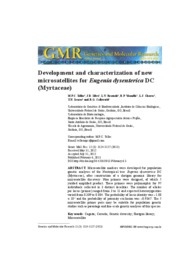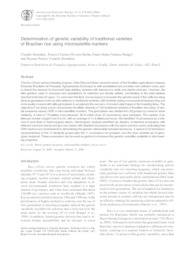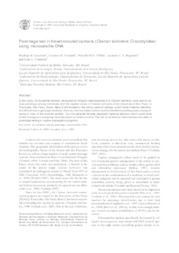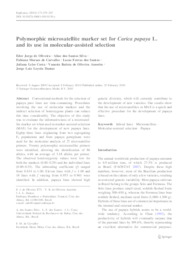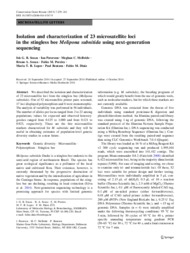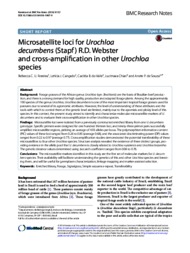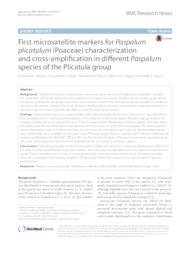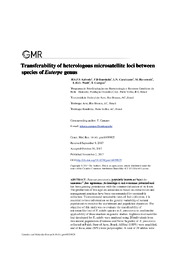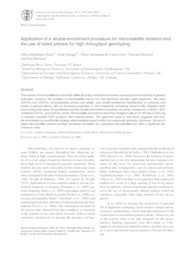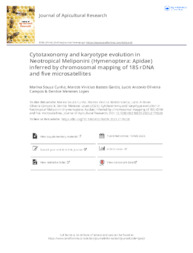Search Publications
Filter by:
| Author(s): TELLES, M. P. C.; SILVA, J. B.; RESENDE, L. V.; VIANELLO, R. P.; CHAVES, L. J.; SOARES, T. N.; COLLEVATTI, R. G. Microsatellite markers were developed for population genetic analyses of the Neotropical tree Eugenia dysenterica DC (Myrtaceae), after construction of a shotgun genomic library for microsatellite dis... ... |
| Author(s): BRONDANI, C.; BORBA, T. C. O.; RANGEL, P. H. N.; BRONDANI, R. P. V. The rice (Oryza sativa) breeding program of the Rice and Bean research center of the Brazilian agricultural company Empresa Brasileira de Pesquisa Agropecuária (Embrapa) is well established and provid... ... |
| Parentage test in broad-snouted caimans (Caiman latirostris, Crocodylidae) using microsatellite DNA. Author(s): ZUCOLOTO, R. B.; VERDADE, L. M.; VILLELA, P. M. S.; REGITANO, L. C. de A.; COUTINHO, L. L. In this study, microsatellite markers, developed for Alligator mississipiensis and Caiman latirostris, were used to assess parentage among individuals from the captive colony of Caiman latirostris at... ... |
| Author(s): OLIVEIRA, E. J. de; SILVA, A. dos S.; CARVALHO, F. M. de; SANTOS, L. F. dos; COSTA, J. L.; AMORIM, V. B. de O.; DANTAS, J. L. L. Conventional methods for the selection of papaya pure lines are time-consuming. Procedures involving the use of molecular markers and the indirect selection of homozygous plants can reduce this time c... ... |
| Author(s): SOUZA, I. G. B.; PATERSON, I.; McBRIDE, M. C.; SOUZA, B. A.; PEREIRA, F. M.; LOPES, M. T. R.; BENTZEN, P.; DINIZ, F. M. We described the isolation and characterization of 23 microsatellite loci from the stingless bee (Melipona subnitida). Out of 52 microsatellite primer pairs screened, 17 loci displayed polymorphism an... ... |
| Author(s): FERREIRA, R. C. U.; CANÇADO, L. J.; VALLE, C. B. do; CHIARI, L.; SOUZA, A. P. de Background: Forage grasses of the African genus Urochloa (syn. Brachiaria) are the basis of Brazilian beef production, and there is a strong demand for high quality, productive and adapted forage plan... ... |
| Author(s): OLIVEIRA, F. A. de; CIDADE, F. W.; FAVERO, A. P.; VIGNA, B. B. Z.; SOUZA, A. P. de Paspalum plicatulum is a perennial rhizomatous grass with natural diploid and polyploid cytotypes. It is a member of Plicatula, which has historically been recognized as a highly complex group contain... ... |
| Author(s): AZÊVEDO, H. F.; BENVINDO, F. D.; CAVALCANTE, L. N.; HAVERROTH, M.; WADT, L. H. de O.; CAMPOS, T. de Euterpe precatoria, popularly known as "açaí-do-amazonas", has agronomic, technological and economic potential and has been gaining prominence with the commercialization of its fruits. The production... ... |
| Author(s): DINIZ, F. M.; IYENGAR, A.; LIMA, P. S. da C.; MACLEAN, N.; BENTZEN, P. The number of microsatellite loci and their allelic diversity contribute to increase accuracy and informativity of genetic estimates, however, the isolation of microsatellite loci is not only laboriou... ... |
| Author(s): CUNHA, M. S.; GARCIA, M. V. B.; CAMPOS, L. A. O.; LOPES, D. M. The Neotropical Meliponini bees, commonly known as stingless bees, are phylogenetically subdivided into three clades in which the chromosome numbers vary from n 1⁄4 8 to n 1⁄4 17. The goal... ... |
Observation
Some of Embrapa's publications are published as ePub files. To read them, use or download one of the following free software options to your computer or mobile device. Android: Google Play Books; IOS: iBooks; Windows and Linux: Calibre.
Access other publications
Access the Agricultural Research Database (BDPA) to consult Embrapa's full library collection and records.
Visit Embrapa Bookstore to purchase books and other publications sold by Embrapa.

